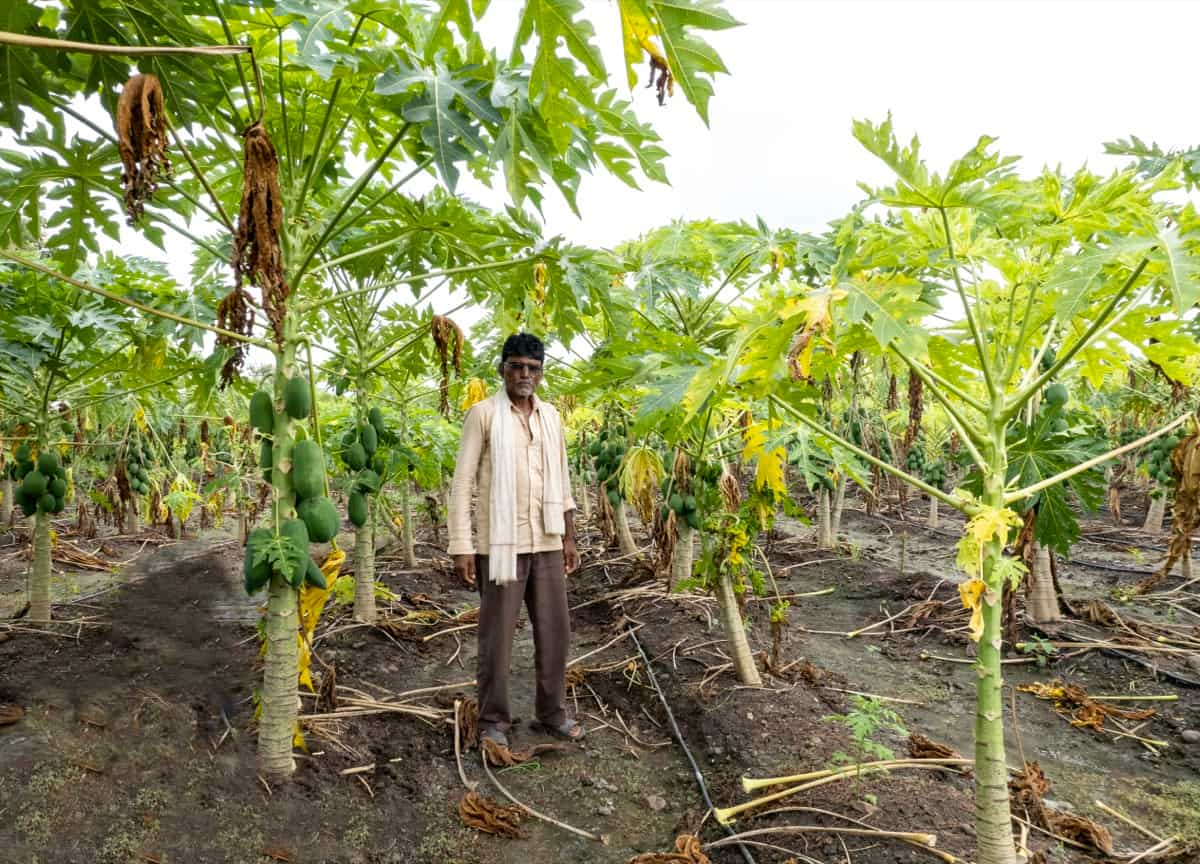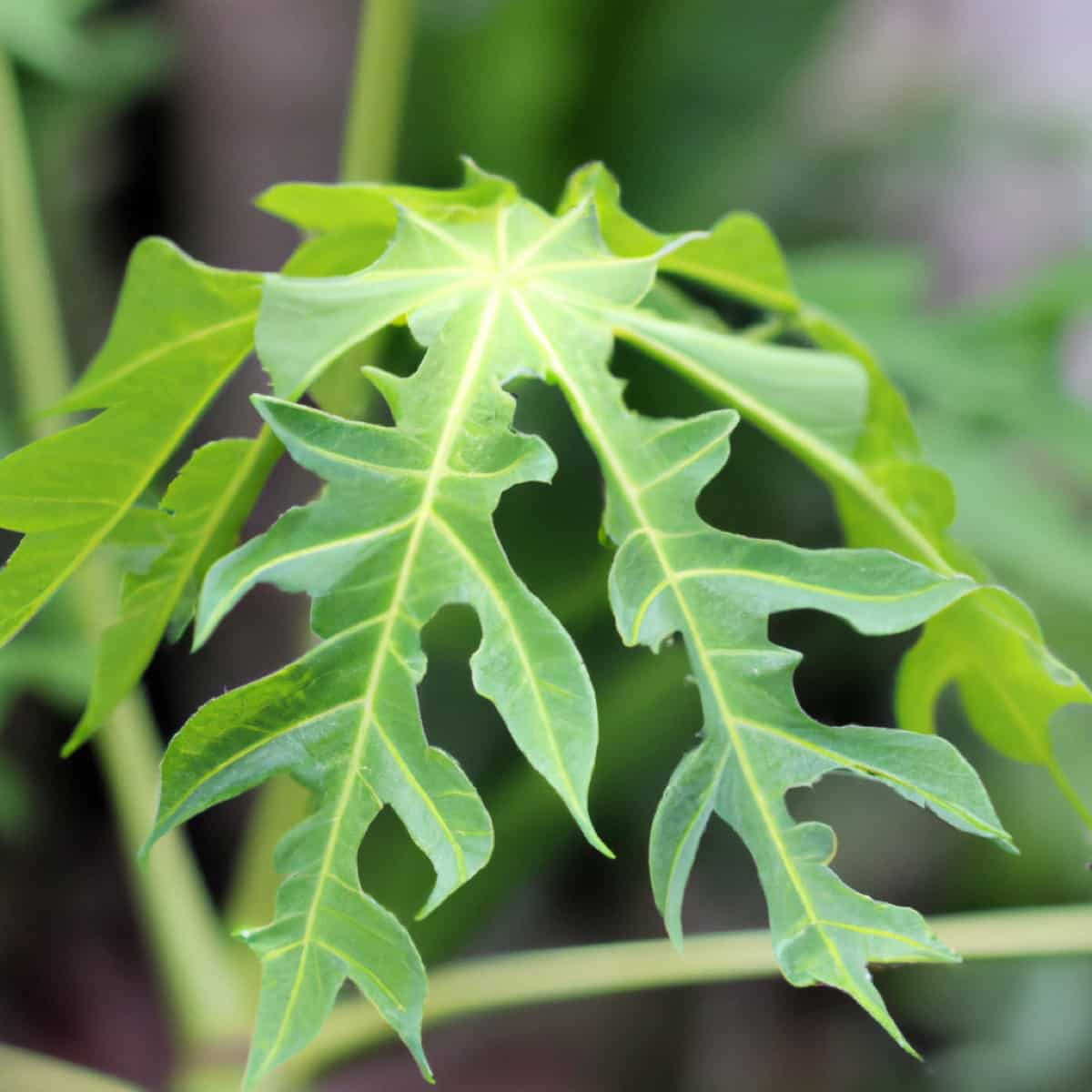Papaya leaf curl is a common disease that affects papaya plants, causing the leaves to curl and become distorted. While chemical treatments are available, many people prefer to use natural and organic methods to treat this condition. Not only are these methods safe for the environment, but they can also effectively control and prevent papaya leaf curl. This document will explore various natural remedies and holistic approaches that can help treat papaya leaf curl.

Natural and Organic Ways to Treat Papaya Leaf Curl
Causes of Leaf Curl In Papaya Plants
Papaya ringspot virus (PRSV) and papaya leaf curl virus (PLCV) are two common viruses that can infect papaya plants. These viruses are transmitted through aphids or other insects feeding on the plant. Infected plants exhibit symptoms such as curled and distorted leaves, stunted growth, and reduced fruit yield.
Lack of essential nutrients like nitrogen, phosphorus, potassium, or magnesium can affect the overall health of the plant and result in leaf curling. High temperature, low humidity, excessive sunlight, and water stress can all contribute to leaf curl in papaya plants. These stressors disrupt the normal physiological processes of the plant, leading to leaf curling as a defense mechanism.
Organic Remedies for Papaya Leaf Curl
Providing adequate nutrition to papaya plants is essential for their overall health and resilience against diseases. Organic fertilizers, like compost or well-rotted manure, can help boost the plant’s immune system and improve its ability to fight infections. Apply the organic fertilizer around the plant’s base, avoiding direct contact with the leaves. Remove Infected Leaves: To prevent the virus’s spread, removing any infected leaves as soon as they are noticed is essential. Be sure to sterilize the pruning tools between cuts to avoid spreading the virus further.
Natural Treatments for Papaya Leaf Curl Disease
A natural treatment for papaya leaf curl is a mixture of garlic and chili peppers. Both garlic and chili peppers have natural fungicidal properties that can help control the disease. To make this remedy, crush a few garlic cloves and chili peppers and soak them in water overnight. Strain the mixture and spray it on the affected leaves. This remedy should be applied every few days until the symptoms subside.
Neem oil is a popular organic insecticide and fungicide that can help control the spread of viruses and pests. It can be applied to the leaves of papaya plants to deter insects and reduce the severity of leaf curl symptoms. Mix neem oil with water according to the instructions on the product label and spray it onto the affected leaves.
Effective Natural Solutions for Papaya Leaf Curl
Sunlight and Ventilation: To thrive, Papaya plants need sufficient sunlight and proper air circulation. Ensure that the plants are placed where they receive at least six hours of sunlight daily. Avoid overcrowding the plants, as it can restrict airflow and create a favorable environment for pests and diseases.
Baking Soda Solution: Baking soda is another effective natural remedy for leaf curl. It helps to control fungal infections and balance the pH levels of the plant. Mix one teaspoon baking soda with one liter of water and spray it on the affected papaya leaves. Repeat this process every two weeks until the leaf curl subsides.
Holistic Approaches to Treating Papaya Leaf Curl
One holistic approach to treating papaya leaf curl is through cultural practices. Proper crop management techniques, like maintaining adequate spacing between plants and ensuring proper irrigation can help reduce the spread of the virus. Additionally, practicing crop rotation and removing infected plant debris can help prevent the disease from recurring in subsequent growing seasons.
In case you missed it: How to Grow and Care for Papaya Bonsai: Planting Instructions

Another important aspect of holistic treatment is enhancing plant immunity. This can be achieved through the use of organic fertilizers and soil amendments that promote the growth of healthy and strong plants. Providing optimal nutrition to papaya plants helps improve their natural defense mechanisms, making them more resistant to viral infections.
Organic Methods to Control Papaya Leaf Curl
practicing crop rotation is essential in organic papaya leaf curl control. Avoid planting papaya in the same location year after year, as this can increase the risk of disease buildup. Rotate your crops to different garden areas to disrupt the virus’s life cycle and reduce the likelihood of leaf curl.
To prevent the spread of leaf curl, practicing good sanitation in your garden is crucial. Remove any infected leaves or plants and dispose of them properly. Avoid using contaminated tools or equipment on healthy plants, as this can spread the virus. Regularly clean and disinfect your gardening tools to minimize the risk of transmission.
Natural Remedies for Papaya Leaf Curl Symptoms
Organic Mulching: Applying a layer of organic mulch around the base of your papaya plants helps retain moisture in the soil, regulates temperature, and suppresses weed growth. Organic mulches, like straw, wood chips, or leaves, can also improve soil fertility as they decompose. Avoid mulching too close to the trunk to prevent rot.
Proper Watering: Overwatering can contribute to the development of leaf curl in papaya plants. Ensure that your plants receive adequate but not excessive watering. Water the plants at the base and not on the foliage. Also, consider using a drip irrigation system to deliver water to the roots and minimize evaporation.
Eco-friendly Ways to Treat Papaya Leaf Curl
Companion Planting: Planting certain companion plants alongside your papaya can help deter pests and promote a healthier ecosystem in your garden. Marigolds, for example, repel aphids and whiteflies, which are known to cause leaf curl. Additionally, planting basil, mint, or lavender can attract beneficial insects that prey on pests.
Organic Fertilizers: Providing your papaya plants with the right nutrients can help them develop strong and healthy leaves, making them more resistant to leaf curl. Use organic fertilizers that are rich in nitrogen, phosphorus, and potassium. Compost, manure, and seaweed-based fertilizers are excellent choices. Apply the fertilizer around the plant’s base and water it in.
Chemical-free Approaches for Managing Papaya Leaf Curl
Whitefly Control: Since whiteflies are a significant vector for the virus that causes papaya leaf curl, it is crucial to control their population. One organic method is using yellow sticky traps, which attract and trap adult whiteflies. These traps can be hung near the papaya plants to help reduce the number of whiteflies.
Biological Control: Introducing beneficial insects, such as ladybugs and lacewings, can help control whitefly populations naturally. These insects feed on whiteflies and their eggs, providing an effective and sustainable pest control method. Attract these beneficial insects by planting flowers such as marigolds and sunflowers near the papaya plants.
In case you missed it: Papaya Contract Farming: A Win-Win Solution for Farmers and Buyers

Conclusion
natural and organic methods offer effective and eco-friendly ways to treat papaya leaf curl. Various approaches can be taken to control and manage this disease, from using neem oil and garlic-chili pepper mixture to improving the plant’s overall health and introducing natural predators. By opting for these methods, you can promote a healthy and thriving papaya plant while minimizing the use of chemicals.
- Feed Your Flock for Less: Top 10 Tips to Save on Chicken Feed
- Ultimate Guide to Ossabaw Island Hog: Breeding, Raising, Diet, and Care
- Hatching Answers: The Top 10 Reasons Your Chickens Aren’t Laying Eggs
- Eggs and Economics: Breaking Down the Cost of Raising Backyard Chickens
- Defend Your Greens: Proven Methods to Keep Iguanas Out of Your Garden
- Ultimate Guide to Cinnamon Queen Chicken: A Comprehensive Guide for Beginners
- Ultimate Guide to California Tan Chicken: Breeding, Raising, Diet, Egg-Production and Care
- Ultimate Guide to Marsh Daisy Chicken: Breeding, Raising, Diet, and Care
- 10 Types of Chicken Farming Businesses You Can Start for Profits